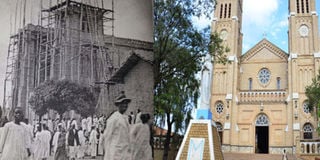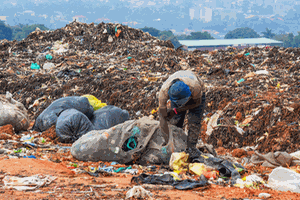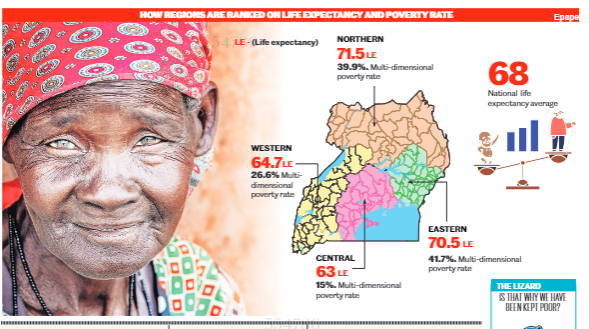Prime
One cathedral three popes

Rubaga Cathedral (L) during the early stages of construction in 1914. Rubaga Cathedral today (R).
The towering house of God stands on top of one of the original seven hills that make up the city of Kampala. Visible from all angles, especially in downtown Kampala, St Mary’s and Sacred Heart Cathedral Rubaga, is indeed a city landmark hardly missed by visitors coming to the Pearl of Africa.
Two popes have been here in the past and one is expected next week. The Cathedral to turn 90 on December 31, 2015, will once again be a centre of attraction during Pope Francis’ visit to Uganda. The pope will hold a service here and meet religious leaders.
It was again here on July 29, 1969 that Pope Paul VI closed the African bishops Synod hosted by Uganda while Pope John Paul II too came here on February 8, 1993, where he met Catholic bishops and priests after a prayer service. He planted a tree in the courtyard and also inaugurated the memorial clock near the parish entrance.
Besides the popes, The Archbishop of Canterbury Robert Runcie on January 28, 1984, visited Rubaga Cathedral and conducted a joint prayer with Emmanuel Cardinal Nsubuga.
So did Archbishop Runcie’s successor George Carey in the early 1990s. Archbishop Carey planted a tree outside the cathedral, which still stands today.
The Rev Fr Charles Lwanga Ssengendo who heads the Kampala Archdiocese Archives Department at Rubaga, rates the Cathedral highly.
“It is the mother of all churches in Uganda whose location was once home to the first Catholic missionaries in this country. The Cathedral’s location being in the metropolitan capital and centre, gives Rubaga cathedral an edge over others,” he said.
Fr Ssengendo, the first Ugandan to study at the prestigious Vatican’s Archives in Rome, says Rubaga Cathedral means a lot to him and a good number of priests in Uganda.
This is where he was ordained priest on the morning of Sunday, November 9, 1980, by Emmanuel Cardinal Nsubuga with three others, Msgr Joseph Njala, Msgr Lawrence Ssemusu and Fr Archilles Kiwanuka.
Four other classmates, Bishop Andrew Zziwa of Kiyinda Mityana, Msgr John Wynand Katende, Fr Expedito Musoke and Fr Denis Luntamye were on the other hand ordained in their respective parishes around the same time.
And this is not all, Fr Ssengendo’s grandmother, Adela Nakabugo Katonda Akola Ebirungi as a school girl in the 1920s, too participated in carrying bricks for the construction of the cathedral all the way from the kiln located at Nalukolongo in Kampala.
Adela died a happy woman in 1988 aged 88 seeing the magnificent cathedral whose foundation she once glanced at.
St Mary’s Cathedral Rubaga as seen today is said to accomodate 5,000 worshippers.
It is 248 feet long (260 if the walls are considered) and 63 feet wide. The transept measures 152 feet (162 including the walls) while the height from the floor to the ceiling is 50 feet.
Some 2.5 million bricks were used to complete the Cathedral. The idea of building this “mother-of-all” churches in Uganda came from Bishop Henry Halon in 1901 who launched an appeal to all Catholics to contribute financially towards a building fund.
Contributions start
The first appeal brought in 6,522 Rupees (about Shs13,000). Brick kilns were put up at Nalukolongo and Kisubi.
In 1911 St Joseph’s Technical School was founded at Kisubi with the help of Bro Herman of the White Fathers to train carpenters, builders, blacksmiths and others, all this in view of the needs foreseen for the building of Rubaga Cathedral.
Chosen to head the building of the cathedral was Bro Cyprian. He decided to put up a “test building”, the present Parish Church at Kisubi.
He reduced to scale the plan of would- be Rubaga Cathedral using one wing as the plan of Kisubi.
By building this small church, Bro Cyprian aimed at training the students of the technical school in readiness for the task they would need to perform at Lubaga.
One of the main tests was to see how the arches would support the weight in the walls and roof. Everything proved satisfactory and the Kisubi church was completed in 1913, a year before the construction of Rubaga Cathedral started in 1914.
At Rubaga, Catholics shared in the construction work, with everyone coming to Mass in the morning stopping at Nalukolongo kiln and taking a number of bricks on the head to the building site on top of Rubaga hill.
The powerful Stanislas Mugwanya, then a Buganda regent, used to lead the procession every morning with four bricks on his head. From the Kisubi kiln, the bricks and other materials were brought to Rubaga by an oxcart as there were no vehicles in Uganda then.
Charles Lwanga, 69 a resident of Rubaga in Musigula zone, says his grandfather Edmond Ssempiira participated in carrying the bricks to the building site.
He told a story that Christians who volunteered to do this work would be rewarded with Virgin Mary medals (midaali) but because of the huge task involved, they would at times get too tired and skip the work. They would say in Lugand: Owange ssika mudaali, meaning, I would rather miss a medal.
Bro Cyprian and his foreman, Matayo Bakaluba started the work of building the cathedral on May 3, 1914 and by October 14, 1914 the foundation had reached the ground level and consumed 500,000 bricks.
The work had to be interrupted for two and half years during World War I (1914-1918) due to lack of funds. The cathedral was completed in 1924 and consecrated on December 31, 1925. Available records indicate that Ugandans alone contributed Shs87,167 (a big amount then), The Catholics of Europe, America, and Canada parted with Shs379,302 while the missionaries of Africa Vicariate gave Shs23,896.
The cathedral’s Roman style was adopted from Normandy in France by Bro Gilbert, the main architect.
The great altar of Muvule tree was the work of Bro Sylvester and took two years to complete.
As for the cathedral’s bells, they were offered by Mr FM Alcouffe from Averyon, France, and bought from Annecy Vieux, France in 1925.
The cathedral ceiling is made of molded metal sheets bought in London by bishop Forbes while the first glass windows were installed by Bishop Edward Michaud, who died on June 18, 1945, and buried inside the Cathedral. Outside the church, the popular giant Virgin Mary statue overlooking the city of Kampala was brought all the way from Italy and installed by Bro Antonius.
Kabaka Mwanga's generosity
While former Kabaka Daniel Basamula Mwanga is known all over the world for ordering the killing of the Uganda Martyrs, he should at least be praised for something good, his generosity in donating the Lubaga hill to the early Catholic missionaries through Bishop Joseph Hirth in 1891. The place where the cathedral is currently located was once a palace for Buganda’s Kabaka Muteesa I, Mwanga’s father.
For starters, the current cathedral is the seventh to occupy the Rubaga hill. Between 1891 and 1914 when the construction of the current cathedral began, the hill gave shelter to six “cathedrals” made up different structures which unfortunately all disappeared under different circumstances.
The first church to be built here was destroyed on January 24, 1892, at about 8pm during the so called religious wars. Later, two more grass-thatched cathedrals were built within a year, with the first one being destroyed by an earthquake and the other burnt down by Protestants (Anglicans).
But the Christians of Rubaga were determined. In 1893 they built a temporary church which was later replaced by a more solid building in 1894.
This church was used until 1901. Because of the growing Catholic population around Rubaga, the need for a larger church arose. Thus the sixth new church was put up in 1901 and this time free of mud.
The sun-dried bricks were used though it still had a grass-thatched roof. It was 71 feet long and 21 feet broad and was blessed by bishop Henry Halon on March 19, 1901. It was used for 24 years. Around this time prominent Catholics like Stanislas Mugwanya during Mass would stay outside watching with an ancient wooden gun just in case Protestants invaded.
He would only go inside the church for Holy Communion and return immediately to keep watch. The present church, a real cathedral in the true sense of the word and status was completed in 1924 before being consecrated in 1925. The construction lasted 10 years.




